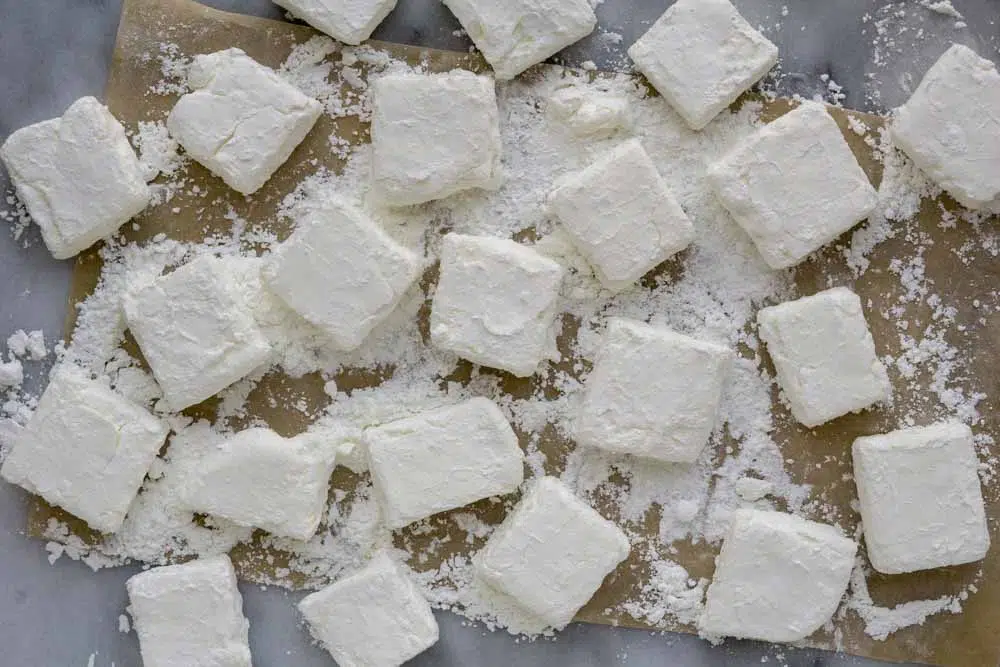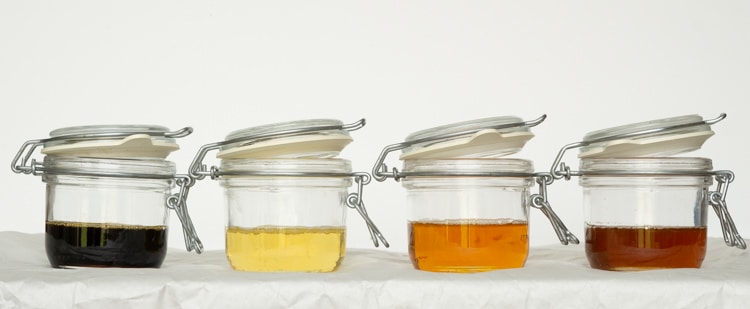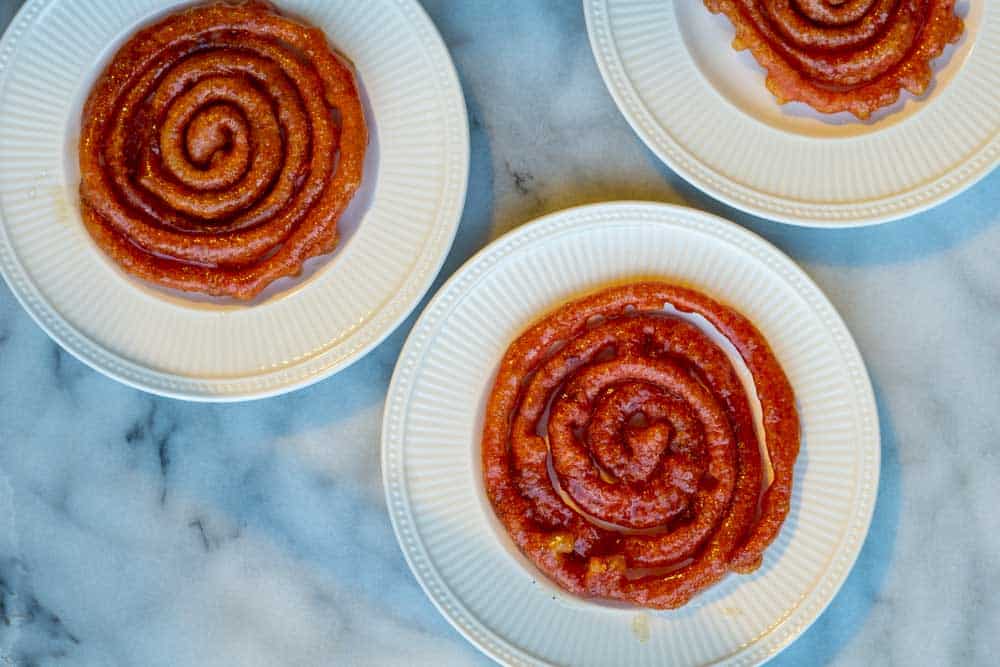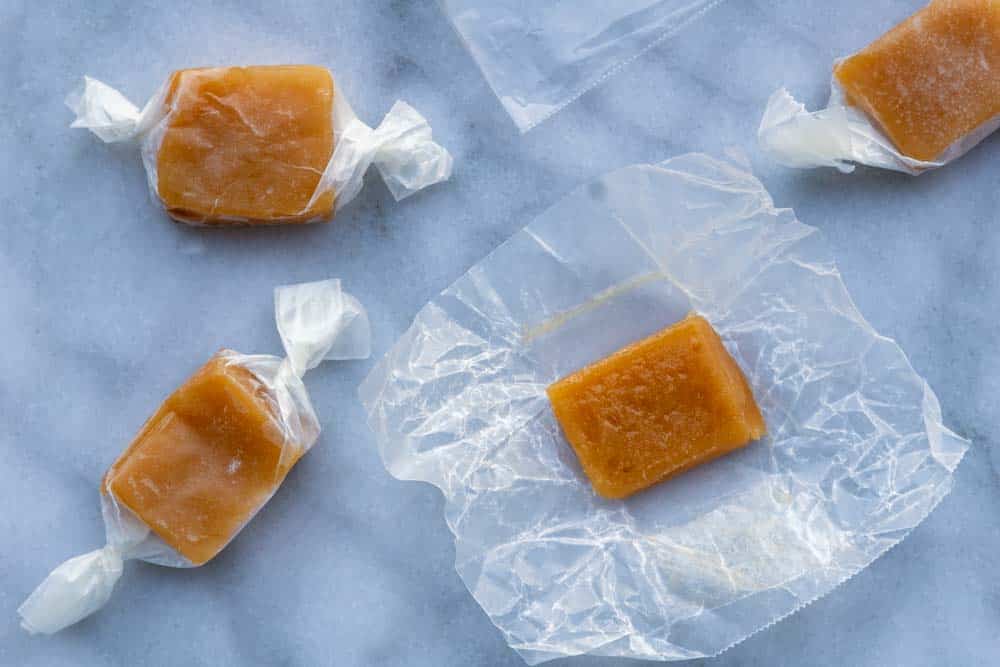Learn the science behind:

The Sugary Science Behind Candy Making
Want to make your own sugar candy? Develop your own recipes? Maybe even start your own candy-making business?
But do you feel like you’re only able to follow a recipe? Scared that even the slightest tweak will result in a failure? Not truly sure of why you’re using that thermometer? You can make candy, but don’t feel like you’ve truly mastered it?
If on top of that, you also enjoy discussing science here and there, and doing an experiment or two, you’ve come to the right place: the starting point of your candy science journey!
Here on FoodCrumbles we’ve written about the science and the why behind candy quite a bit. We’ve even developed a course about the science of candy. This is the place where we bring it all together, to help you become a better candy maker. Whether you’re making candy at home, or in the factory. Understanding the basics will help you improve for sure.
A quick overview of the science behind candy
Caramels, marshmallows, fudge, borstplaat, barfi, brittle, honeycomb, and licorice. Soft, hard, chewy, brittle, grainy, solid, or airy. There are so many different types of sugar-based candy in this world!
But, once you start to have a closer look at them. You’ll realize that there are a lot of similarities. For one thing, almost all of them rely on one major ingredient: sugar.
How come you can create so many seemingly totally different sweets using this one crucial ingredient as the star?
Getting started: Candy starts with sugar
Most candies, unless they’re sugar-free, rely on sugar to become what they are. Of course, other ingredients may play a key role as well, but sugar is often the foundation of just about any candy.
There are several different types of sugars. Glucose, fructose, lactose and sucrose are some of the sugars you’d most commonly find in candy. All of them are small carbohydrates.
By far the most common sugar in candy though is sucrose, also called saccharose. It is a so-called disaccharide and is formed when glucose and fructose react together to form one molecule. Sucrose is a very unique molecule. It is the key to making candy of all different types. Soft, hard, brittle, chewy. The interaction of sucrose with water is key for all of them!
Concept 1: Cooking a sugar syrup
Have a close look at your sugar candy recipe. Does it start by adding sugar and water to a pot and bringing it to a boil? It quite likely is the case! This first step is crucial and greatly impacts the final texture and structure of your candy.
While boiling sucrose + water you’re essentially concentrating sugar. You’re evaporating more and more water, until you’ve achieved the sugar concentration that you need for your specific candy.
A good measure for determining whether you’ve cooked your sugar syrup sufficiently is by measuring the temperature of the boiling sugar solution. The temperature and concentration of the sugar syrup are closely related. The hotter the sugar solution, the more concentrated it is. The concentration again impacts the consistency of your candy. Sugar syrups cooked to higher temperatures result in glassy, brittle candy, whereas those cooked to lower temperatures may be syrupy or soft.
Further Learning
The Stages of Cooking Sugar Solutions – Candy Making Basics
Learn more about the different “stages” a sugar syrup goes through during cooking. From syrup to soft ball, to hard crack.


The Science Behind Cooking Sugar Syrups For Candy Making
Learn more about the science behind cooking sugar syrups, and why they can form the basis of so many candies.
Light, sweet, but very stable. Marshmallows fall into a special candy category: they have been aerated. That is, they contain a lot of air. Nevertheless, cooking the sugar syrup to the right temperature still plays a crucial role.


What is the glass transition temperature?
A useful concept to understand when making candy is the so-called glass transition temperature. It can help you understand why candy is brittle and hard vs. flexible and viscous.

This style of candy requires cooking a sugar syrup with a little acid (to induce inversion) to quite a high temperature. It then allows the sugar mass to be pulled!
Concept 2: Controlling sugar crystallization
Once you’ve boiled off enough water of your sugar solution, and reached the required concentration, it’s time to cool candy back down. This also is a crucial part of candy making. And, it may seem simple, but again, what you do in this step can have a huge impact on the final candy.
The main concept at play here is crystallization (or not) of sugar. In some candy, you want to force crystallization of sugars. In others you do not. Crystalline sugar can make a candy grainy, but it can also make it more brittle and less chewy.
When the concentration of sugar is at the correct value, you can induce crystallization by shearing the sugar, or by adding other sugar crystals.
Further learning

How to Make Fudge – Controlling Crystallization
Fudge gets its characteristic texture from the presence of lots of tiny sugar crystals. Controlling and initiating crystallization are crucial for a good fudge!
Making Confectionery Fondant: Controlling Sugar Crystallization
Fondant is another example of a candy that contains a lot of tiny sugar crystals. Fondant is often used to help initiate crystallization in other candies as well, by adding a little into the recipe.


The Science of Dutch ‘Borstplaat’ – A Crystalline Candy (+ Recipe)
You can make borstplaat, a Dutch confection, closely related to fudge, with fondant. Again, you want to form sugar crystals to create a delicate melt in the mouth texture.
How to Make Rock Sugar – Using Supersaturation Science
Rock sugar is quite an extreme example of crystalline candy. As a matter of fact, rock sugar is crystalline sugar. It is made up of several very large crystals.

Concept 3: Caramelization
Want to add a little color and flavor to your candy? You can do so without using any additional ingredients but by treating your existing ingredients differently.
When you heat sugar to very high temperatures, well above the boiling point of water, it will start to caramelize. As a result the sugar turns brown and a lot of new flavor molecules are formed. Caramelizing sugar only requires heat, but it can be tricky to get right since sugar may want to crystallize before it has a chance to caramelize. If that happens, you’d have to start over again.
Further learning

The Science of Caramelization – Food Chemistry Basics
Take a deep dive into the chemistry behind caramelization. What really happens to the sugar during this reaction and how can you control it?
How to Caramelize Sugar: Dry vs Wet Method
There are two key ways to caramelize sugar, using either the dry or the wet method. The dry method just uses sugar and heat whereas you also add in some water for the wet method.
Both make the same caramelized sugar, but, one can be easier to do than the other.

Concept 4: Maillard reaction
So far, all the science we’ve discussed revolves around sugar. How to get it to form certain textures, or how to give it flavor. However, a lot of candies contain a range of other ingredients that will impact the final candy quality.
If you add an ingredient with proteins, such as milk, you may actually initiate another chemical reaction: the Maillard reaction. This reaction starts at lower temperatures than caramelization and can bring a lot of color and flavor to candy as well!
Further learning

Food Chemistry – What is The Maillard Reaction?
The Maillard reaction is a reaction between sugars and proteins that also leads to the formation of brown molecules and a range of flavor molecules. It can occur when you heat sugar with protein-containing ingredients such as milk.
Controlling Color & Flavor of Sugar Syrups – Steering Browning Reactions
When making sugar syrups, you can just boil sugar + water. You’ll end up with a transparent, sweet syrup. However, you can also mix things up a little to change what’s going on. This way you can make syrups with a range of colors and flavors!

Different types of candy
So much for the theory. How about putting all of that knowledge into practice? Once you grasp these few concepts, candy-making will become a lot easier. You will understand how (not) to change recipes to get what it is you’re looking for.
As we mentioned at the start. There are countless types of candy and what you would call a candy might even depend on where you’re from. Here, we’re listing some of the candies that we discuss in more detail elsewhere.

What is Dutch liquorice (drop)?
Some very regional candy styles are Dutch and Scandinavian licorice. The use of not just licorice root, but also ammonia salts give these candies a very unique taste. Loved by some, despised by many others!
The Science of Honeycomb Candy (+ Troubleshooting Tips)
Honeycomb is a light and airy, but very brittle type of candy. If it weren’t for these air bubbles within, it would be rock solid for sure!
Honeycomb is really just a cooked sugar solution mixed with a little bit of baking soda to create airiness.


Sweet Science: How to Make Jalebi
Maybe not your typical candy, but, it’s illustrative for many similar confections: something baked or fried soaked in a sugar syrup. The sugar syrup adds sweetness, as well as flavor.
How to Make Caramel (+ Recipe Troubleshooting)
Little cubes of caramel, eaten as is, or covered in chocolate are a very common candy type. And, they’re one of the simpler types to make and store. To create the correct texture though, you have to control cooking your sugar syrup well!


Combine cookies with caramel sauce for a typical Dutch treat: stroopwafels. It’s where candy & cookie science meet to make something even more delicious.
Turkish delight is its own category of candy. Aside from using a hot sugar syrup, it requires corn starch to make its characteristic soft, but squeaky structure. It’s not the easiest of candies to make for a home candy maker, mostly because it requires some experience to determine whether it’s been cooked enough. Your thermometer can only help to an extent here!


Just as airy as marshmallows, but not as bouncy: nougat. Nougat also contains a lot of air bubbles, but is quite a bit firmer, and often contains some added nuts as well.
Want to learn more?
Did we pique your interest? But feel that there is still much more to learn about the science behind candy? Want to dive even deeper into some of these candy science concepts? If so, why not sign up for our mini-course on the science behind candy making!
What's your challenge?
Struggling with your food product or production process? Not sure where to start and what to do? Or are you struggling to find and maintain the right expertise and knowledge in your food business?
That's where I might be able to help. Fill out a quick form to request a 30 minute discovery call so we can discuss your challenges. By the end, you'll know if, and how I might be able to help.





